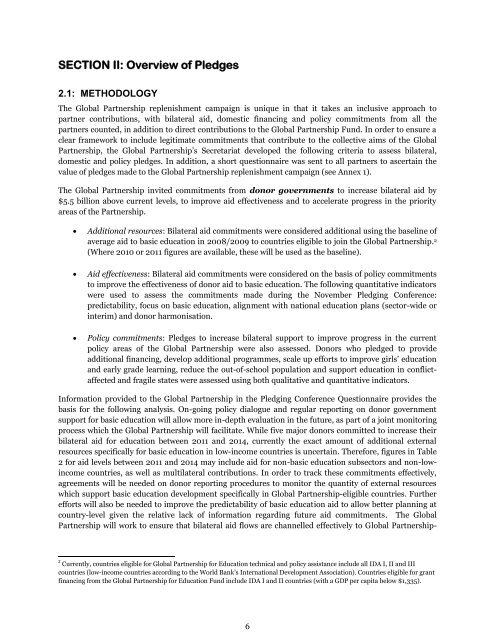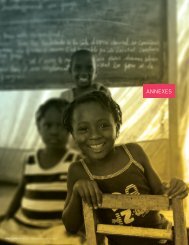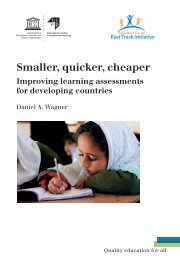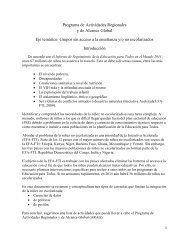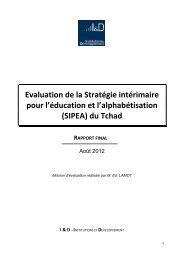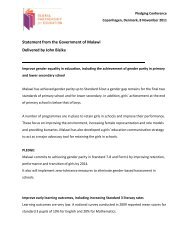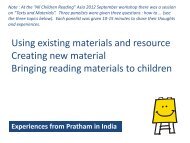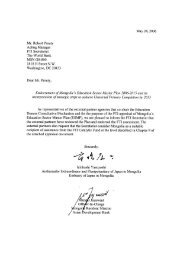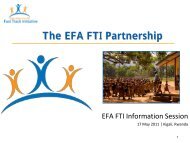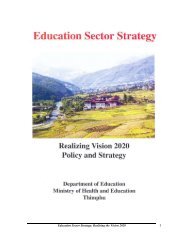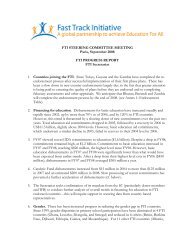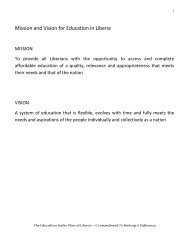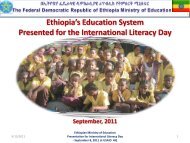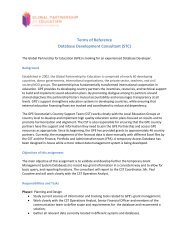Pledges to the Global Partnership for Education
Pledges to the Global Partnership for Education
Pledges to the Global Partnership for Education
Create successful ePaper yourself
Turn your PDF publications into a flip-book with our unique Google optimized e-Paper software.
SECTION II: Overview of <strong>Pledges</strong><br />
2.1: METHODOLOGY<br />
The <strong>Global</strong> <strong>Partnership</strong> replenishment campaign is unique in that it takes an inclusive approach <strong>to</strong><br />
partner contributions, with bilateral aid, domestic financing and policy commitments from all <strong>the</strong><br />
partners counted, in addition <strong>to</strong> direct contributions <strong>to</strong> <strong>the</strong> <strong>Global</strong> <strong>Partnership</strong> Fund. In order <strong>to</strong> ensure a<br />
clear framework <strong>to</strong> include legitimate commitments that contribute <strong>to</strong> <strong>the</strong> collective aims of <strong>the</strong> <strong>Global</strong><br />
<strong>Partnership</strong>, <strong>the</strong> <strong>Global</strong> <strong>Partnership</strong>‟s Secretariat developed <strong>the</strong> following criteria <strong>to</strong> assess bilateral,<br />
domestic and policy pledges. In addition, a short questionnaire was sent <strong>to</strong> all partners <strong>to</strong> ascertain <strong>the</strong><br />
value of pledges made <strong>to</strong> <strong>the</strong> <strong>Global</strong> <strong>Partnership</strong> replenishment campaign (see Annex 1).<br />
The <strong>Global</strong> <strong>Partnership</strong> invited commitments from donor governments <strong>to</strong> increase bilateral aid by<br />
$5.5 billion above current levels, <strong>to</strong> improve aid effectiveness and <strong>to</strong> accelerate progress in <strong>the</strong> priority<br />
areas of <strong>the</strong> <strong>Partnership</strong>.<br />
<br />
<br />
<br />
Additional resources: Bilateral aid commitments were considered additional using <strong>the</strong> baseline of<br />
average aid <strong>to</strong> basic education in 2008/2009 <strong>to</strong> countries eligible <strong>to</strong> join <strong>the</strong> <strong>Global</strong> <strong>Partnership</strong>. 2<br />
(Where 2010 or 2011 figures are available, <strong>the</strong>se will be used as <strong>the</strong> baseline).<br />
Aid effectiveness: Bilateral aid commitments were considered on <strong>the</strong> basis of policy commitments<br />
<strong>to</strong> improve <strong>the</strong> effectiveness of donor aid <strong>to</strong> basic education. The following quantitative indica<strong>to</strong>rs<br />
were used <strong>to</strong> assess <strong>the</strong> commitments made during <strong>the</strong> November Pledging Conference:<br />
predictability, focus on basic education, alignment with national education plans (sec<strong>to</strong>r-wide or<br />
interim) and donor harmonisation.<br />
Policy commitments: <strong>Pledges</strong> <strong>to</strong> increase bilateral support <strong>to</strong> improve progress in <strong>the</strong> current<br />
policy areas of <strong>the</strong> <strong>Global</strong> <strong>Partnership</strong> were also assessed. Donors who pledged <strong>to</strong> provide<br />
additional financing, develop additional programmes, scale up ef<strong>for</strong>ts <strong>to</strong> improve girls‟ education<br />
and early grade learning, reduce <strong>the</strong> out-of-school population and support education in conflictaffected<br />
and fragile states were assessed using both qualitative and quantitative indica<strong>to</strong>rs.<br />
In<strong>for</strong>mation provided <strong>to</strong> <strong>the</strong> <strong>Global</strong> <strong>Partnership</strong> in <strong>the</strong> Pledging Conference Questionnaire provides <strong>the</strong><br />
basis <strong>for</strong> <strong>the</strong> following analysis. On-going policy dialogue and regular reporting on donor government<br />
support <strong>for</strong> basic education will allow more in-depth evaluation in <strong>the</strong> future, as part of a joint moni<strong>to</strong>ring<br />
process which <strong>the</strong> <strong>Global</strong> <strong>Partnership</strong> will facilitate. While five major donors committed <strong>to</strong> increase <strong>the</strong>ir<br />
bilateral aid <strong>for</strong> education between 2011 and 2014, currently <strong>the</strong> exact amount of additional external<br />
resources specifically <strong>for</strong> basic education in low-income countries is uncertain. There<strong>for</strong>e, figures in Table<br />
2 <strong>for</strong> aid levels between 2011 and 2014 may include aid <strong>for</strong> non-basic education subsec<strong>to</strong>rs and non-lowincome<br />
countries, as well as multilateral contributions. In order <strong>to</strong> track <strong>the</strong>se commitments effectively,<br />
agreements will be needed on donor reporting procedures <strong>to</strong> moni<strong>to</strong>r <strong>the</strong> quantity of external resources<br />
which support basic education development specifically in <strong>Global</strong> <strong>Partnership</strong>-eligible countries. Fur<strong>the</strong>r<br />
ef<strong>for</strong>ts will also be needed <strong>to</strong> improve <strong>the</strong> predictability of basic education aid <strong>to</strong> allow better planning at<br />
country-level given <strong>the</strong> relative lack of in<strong>for</strong>mation regarding future aid commitments. The <strong>Global</strong><br />
<strong>Partnership</strong> will work <strong>to</strong> ensure that bilateral aid flows are channelled effectively <strong>to</strong> <strong>Global</strong> <strong>Partnership</strong>-<br />
2 Currently, countries eligible <strong>for</strong> <strong>Global</strong> <strong>Partnership</strong> <strong>for</strong> <strong>Education</strong> technical and policy assistance include all IDA I, II and III<br />
countries (low-income countries according <strong>to</strong> <strong>the</strong> World Bank‟s International Development Association). Countries eligible <strong>for</strong> grant<br />
financing from <strong>the</strong> <strong>Global</strong> <strong>Partnership</strong> <strong>for</strong> <strong>Education</strong> Fund include IDA I and II countries (with a GDP per capita below $1,335).<br />
6


